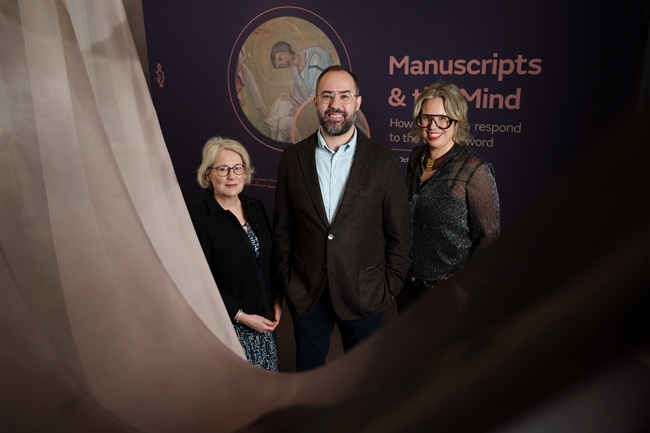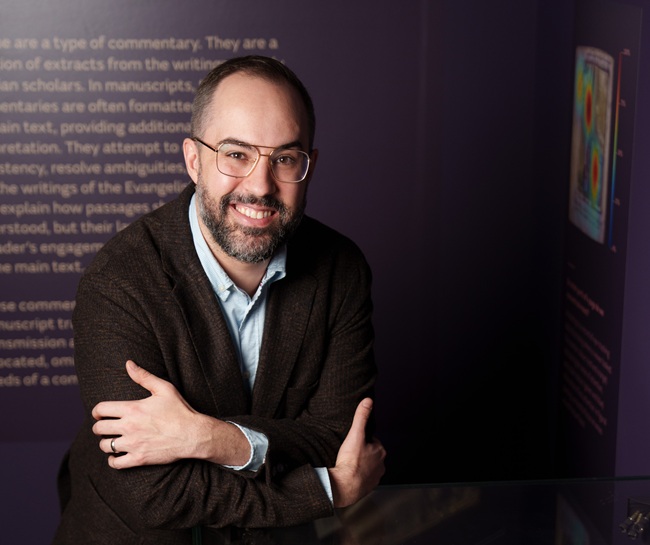Manuscripts & the Mind: A new exhibition turns visitors into researchers
Published: 24 October 2025
A new exhibition, Manuscripts & the Mind: How we read & respond to the written word, has opened at the Chester Beatty, Dublin.

Manuscripts & the Mind explores the hidden language of books and encourages visitors to engage with the texts by looking beyond the words. The exhibition teaches guests to see what’s often invisible, finding hidden layers of meaning within each manuscript.
Opening on 24 October 2025 until 1 March 2026 , this exhibition invites visitors to explore the concealed features of manuscripts and become part of a live research project.
Curated in collaboration with the University of Glasgow and partners across six countries, the exhibition is part of the Paratexts Seeking Understanding project, funded by the Templeton Religion Trust. It brings together manuscript scholars like the University of Glasgow’s Professor Garrick Allen, cognitive scientists and museum curators to explore how the design of books affects how we think, feel and learn.
Together, they formulated experiments to test how manuscripts create knowledge and understanding.
Visitors will encounter rare manuscripts from Buddhist, Christian, Islamic, Jewish and Samaritan traditions and engage with interactive elements that reveal the power of paratexts -the titles, footnotes, borders, and annotations that shape how we read. Along the way, they’ll be invited to take part in surveys, watch eye-tracking videos and explore how their own reading habits compare to those of readers across time and cultures.
These studies and exhibition are examining how people engage with religious texts through the complex network of paratexts – which is any part of a manuscript that is not the main text. The Irish exhibition reveals how paratexts are more than just decorative, they are essential tools that guide and instruct the reader. They fundamentally shape how we interpret, navigate, and understand texts.

Professor Garrick Allen, University of Glasgow, said: “We’re using the exhibition as a public experimental space – it’s a unique blend of science, history and public engagement. An international team of experts in manuscripts and cognitive scientists worked together to create a series of eye-tracking, survey and other studies which run as part of the exhibition. Visitors will be helping us gather new information about how people today interact with ancient texts to help us better understand how those from the past may have engaged with their sacred texts. This exhibition gets at the heart of what it means to read, learn and understand from the written word.”
Fionnuala Croke, Director of the Chester Beatty, said: “Manuscripts & the Mind invites visitors to look at books in a completely new way. The exhibition uncovers the hidden visual and physical elements that shape how we read and think. It’s a celebration of the creativity, craftsmanship, and curiosity that have always defined our engagement with the written word. We’re delighted to share this fascinating exploration of manuscripts from across the world’s great traditions with our audiences.”
Dr Jill Unkel, Curator of Western Collections at the Chester Beatty, said: “Paratexts turn texts into books! This exhibition opens up exactly how we look at book design, and reminds us of the many page features that subtly transform our understanding. Combining scientific, philological and curatorial expertise, visitors can follow where our eyes focus and how our brains interpret.”
Manuscripts & the Mind includes additional interactive and multi-sensory elements, including touchscreens, which allow viewers to help to bring the paratexts to life through animation and a ‘Notes Book’ where people can add their own annotations, doodles and inscriptions. The exhibition also includes works by two exciting contemporary artists responding to the themes in the show.
Some key manuscripts in the exhibition include:
-
Colour-Coded Variants, Suras ‘The Opening’ (al-Fātiḥa) and ‘The Cow’ (al-Baqara), Kitab al-Badi’ – Ibn Khālawayh (d. 980 CE / 370H), Composed for Sayf al-Dawla al-Ḥamdānī (d. 967 CE / 356H), Arabic in eastern kufic script on paper, 980 CE (370H), possibly Aleppo, CBL Ar 3051, ff. 7v–8r. Composed by Ibn Khālawayh for Sayf al-Dawla, this heavily annotated copy of al-Baghawī’s prophetic traditions features notes in multiple directions, including upside-down, reflecting intensive scholarly study and engagement with variant readings of the Qur’an.
-
Reader Notes, Title Page, Tafsīr gharīb al-Qur’ān – Abū Bakr Muḥammad al-Sijistānī (d. 941 CE / 330H), Copied by Abū Manṣūr Mawhūb al-Jawāliqī (d. 1144 CE / 539H), Arabic in naskh script on paper, 1106 (499H), probably Baghdad, CBL Ar 3009, f.1r. Copied by Abū Manṣūr Mawhūb ibn Aḥmad al-Jawāliqī, this manuscript includes a partly obliterated note by historian Aḥmad b. ʿAlī al-Maqrīzī (1421–1422 CE), who consulted and copied excerpts, enhancing the manuscript’s scholarly and historical significance.
-
Formatting, Gospel of John – Acts of the Apostles & Gospel of John, Coptic on parchment, c. 600 CE, Apa Jeremias, Saqqara, CBL Cpt 814, ff. 98v–99r. The opening words feature decorative and textual elements, including birds and a cross, verse markers, and line fillers, guiding readers through the text and highlighting its Christian content. A blank page indicates the Gospel is preceded by another text.
-
Carved Wooden Cover, Condensed Version in Verse of the 'Perfection of Wisdom Sutra' – colours and gold on wood, 1700–1900, Tibet, CBL Tb 1704. The wooden boards protect the manuscript and signal its importance, with a central carving of Shakyamuni flanked by Mañjuśrī and Tārā, combining spiritual symbolism and practical function.
-
Marginal Caption, Sutra of Liberation, Instruction of Akṣayamatinirdeśa Sūtra – Tibetan on indigo-dyed paper, 1700–1900, Tibet, CBL Tb 1708, f.1. This manuscript uses the ‘seven seals’ system, with dots separating syllables and vertical strokes separating verses. Line borders and captions indicate volume, chapter, and page, guiding reading and interpretation of the Sūtra on Liberation (mgyod tshangs / thar mdo).
The exhibition will be accompanied by a series of lectures (Dates: 30 April 2025 – 23 September 2026). The Let’s talk about Paratexts lecture series is to be held at 6pm on Wednesday evenings. For guests attending onsite during the exhibition, each lecture will be followed by a short tour of the exhibition with the Chester Beatty’s Curator of Western Collections, Dr Jill Unkel.
Manuscripts & the Mind: How we read & respond to the written word opens to the public on 24 October 2025 and will run until 1 March 2026.
About the Chester Beatty
Described by Lonely Planet as ‘not just the best museum in Ireland but one of the best in Europe’, the Chester Beatty is the pre-eminent Irish museum promoting the appreciation and understanding of world cultures with holdings of manuscripts, rare books, and other treasures from Europe, the Middle East, North Africa and Asia. An engaging and welcoming space, visitors from Ireland and overseas will find permanent and temporary displays, an intercultural learning programme and a broad variety of public activities for all ages and backgrounds. Learn more: Chester Beatty
First published: 24 October 2025

